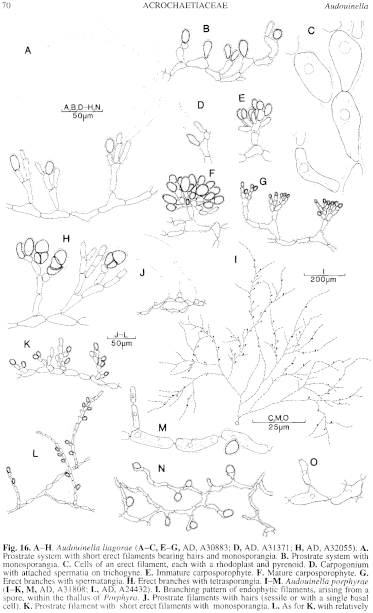|
|
|
|
|
|||||||||||
|
Electronic Flora of South Australia Species Fact Sheet
Phylum Rhodophyta – Class Florideophyceae – Order Acrochaetiales – Family Acrochaetiaceae
Selected citations: Garbary 1987: 104.
Synonyms
Chantransia liagorae Boergesen 1915: 57.
Acrochaetium liagorae Boergesen 1915: 58, figs 60–62. Abbott 1962a: 100, figs 8,9.
Acrochaetium collinsianum Boergesen 1920: 454. Levring 1953: 486.
Thallus (Fig. 16A, B) entirely or largely endophytic, developing from septate persistent or aseptate non-persistent spores. Prostrate system (Fig. 16A, B) consisting of sparingly and irregularly branched discrete filaments creeping within the gelatinous matrix of the host, occasionally decumbent or bearing branches descending towards the centre of the host. Cells (Fig. 16A, B, H) irregular to subcylindrical, (6–) 8–12 (–15) µm in diameter and (12–) 25–40 (–80) µm long, L/D (1–) 2–4 (–8), often widest in their middle. Erect filaments (Fig. 16A, B, H) arising at irregular intervals from cells of the prostrate filaments, simple or sparingly and irregularly branched, up to 400 µm long. Cells irregular to cylindrical in shape, (3–) 8–15 µm in diameter and 15–30 (–50) µm long, L/D (1–) 2–4 (–5), each cell containing a lobate to stellate (Fig. 16C) rhodoplast and a single pyrenoid. Terminal and pseudolateral hairs up to 450 µm long occur.
Reproduction: Monosporangia (Fig. 16A, B) ovoid, 10–14 (–18) µm in diameter and 13–24 (–35) µm long, terminal or lateral, sessile or stalked, on both prostrate and erect filaments.
Thalli monoecious or dioecious. Carpogonia (Fig. 16D) sessile or on 1–2-celled stalks on prostrate and erect filaments, dividing transversely after fertilization and giving rise to a
Tetrasporangia (Fig. 16H) occasional, replacing monosporangia, 15–18 µm in diameter and 22–30 (–35) µm long, cruciately divided.
Type from the south coast of St Croix, Virgin Is; holotype in C.
Selected specimens: Pennington Bay, Kangaroo I., S. Aust., in Liagora harveyana, rear eulittoral (Womersley, 22.i.1947; AD, A30883). Antechamber Bay, Kangaroo I., S. Aust., upper sublittoral on jetty piles [Woelkerling, 20.xi.1967; AD, A32055 (in Helminthocladia australis) -"Marine Algae of southern Australia" No. 63; and AD, A32696 (in H. densa)]. Barker Rocks, Yorke Pen., S. Aust., in Liagora harveyana (Woelkerling, 12.iii.1967; AD, A31371). Petrel Cove, Victor Harbor, S. Aust. (Woelkerling, 15.i.1968; AD, A32122).
Distribution: Bermuda; Dry Tortugas; Hawaii; Juan Fernandez I.; Philippines; Virgin Is.
In southern Australia, from Port Rickaby to Victor Harbor, S. Aust., including Kangaroo I.; in Helminthocladia spp. and Liagora spp. Probably more widespread in these hosts.
Taxonomic notes: Monosporangia borne on plants with poorly developed erect filaments tend to be smaller (10–13 µm in diameter and 13–22 µm long) than those [12–14 (–18) µm in diameter and 18–26 (–35) µm long] on plants with well-developed erect filaments.
Stegenga (1985, p. 297, 328) infers that A. liagorae is a synonym of Acrochaetium brebneri (Batters) Stegenga.
References:
ABBOTT, I.A. (1962a). Some Liagora - inhabiting species of Acrochaetium. Occ. Pap. Bernice P. Bishop Mus. 23, 77–120.
BOERGESEN, F. (1915). The marine algae of the Danish West Indies. Part 3. Rhodophyceae. Dansk bot. Ark. 3, 1–80.
BOERGESEN, F. (1920). The marine algae of the Danish West Indies. Part 3. Rhodophyceae. Dansk bot. Ark. 3, 369–504.
GARBARY, D.J. (1987). The Acrochaetiaceae (Rhodophyta): An annotated bibliography. Bibl. Phycol. 77, 1–267.
LEVRING, T. (1953). The marine algae of Australia. I. Rhodophyta: Goniotrichales, Bangiales and Némalionales. Arkiv för Bot. Ser. 2, 2, 457–530.
STEGENGA, H. (1985). The marine Acrochaetiaceae (Rhodophyta) of southern Africa. S. Afr. J. Bot. 51, 291–330.
WOELKERLING, W.J. (1971). Morphology and taxonomy of the Audouinella complex (Rhodophyta) in southern Australia. Aust. J. Bot. Suppl. 1, 1–91.
The Marine Benthic Flora of Southern Australia Part IIIA complete list of references.
Publication:
Womersley, H.B.S. (14 January, 1994)
The Marine Benthic Flora of Southern Australia
Rhodophyta. Part IIIA, Bangiophyceae and Florideophyceae (to Gigartinales)
Reproduced with permission from The Marine Benthic Flora of Southern Australia Part IIIA 1994, by H.B.S. Womersley. Australian Biological Resources Study, Canberra. Copyright Commonwealth of Australia.
Illustration in Womersley Part IIIA, 1994: FIG. 16 A–H.

Figure 16 enlarge
Fig. 16. A–H. Audouinella liagorae (A–C, E–G, AD, A30883; D, AD, A31371; H, AD, A32055). A. Prostrate system with short erect filaments bearing hairs and monosporangia. B. Prostrate system with monosporangia. C. Cells of an erect filament, each with a rhodoplast and pyrenoid. D. Carpogonium with attached spermatia on trichogyne. E. Immature carposporophyte. F. Mature carposporophyte. G. Erect branches with spermatangia. H. Erect branches with tetrasporangia. 1-M. Audouinella porphyrae (I–K, M, AD, A31808; L, AD, A24432). I. Branching pattern of endophytic filaments, arising from a spore, within the thallus of Porphyra. J. Prostrate filaments with hairs (sessile or with a single basal cell). K. Prostrate filament with short erect filaments with monosporangia. L. As for K, with relatively long erect filaments. M. Cells of prostrate and short erect filaments each with a rhodoplast and pyrenoid, and a monosporangium. N, 0. Audouinella bonnemaisoniae (AD, A32120). N. Part of thallus with monosporangia, within the host thallus. 0. Cells each with a rhodoplast and pyrenoid. [A–H, J–L, N after Woelkerling 1971.

|
Email Contact: State Herbarium of South Australia |

|